
Overcoming the Top 10 Challenges Faced by Introduction to Business Instructors
 Teaching an Introduction to Business course can be both rewarding and challenging. Instructors must navigate various obstacles to effectively engage students and deliver a comprehensive understanding of the business world. In this article, we will explore the ten great challenges faced by Introduction to Business instructors and provide specific suggestions for overcoming these challenges.
Teaching an Introduction to Business course can be both rewarding and challenging. Instructors must navigate various obstacles to effectively engage students and deliver a comprehensive understanding of the business world. In this article, we will explore the ten great challenges faced by Introduction to Business instructors and provide specific suggestions for overcoming these challenges.
Diverse student backgrounds: Challenge: Students come from various backgrounds, with different levels of business knowledge and experience. Solution: Conduct a pre-course survey to assess students' backgrounds and tailor the course content accordingly. Provide additional resources and support for students who may need extra help.
Keeping content up-to-date: Challenge: The business world is constantly evolving, and course material can quickly become outdated. Solution: Regularly update course content to include current events, case studies, and emerging trends. Encourage students to share relevant news articles and discuss their implications in class.
Balancing theory and practice: Challenge: Striking the right balance between theoretical concepts and practical applications can be difficult. Solution: Incorporate real-world examples, guest speakers, and case studies to demonstrate how theories apply in practice. Assign projects that allow students to apply their knowledge to real business scenarios.
Engaging students in online courses: Challenge: Keeping students engaged and motivated in online courses can be challenging. Solution: Use interactive elements such as discussion forums, live Q&A sessions, and group projects to foster engagement. Provide timely feedback and encourage student participation.
Addressing different learning styles: Challenge: Students have different learning preferences, such as visual, auditory, or kinesthetic. Solution: Incorporate a variety of teaching methods, including lectures, discussions, videos, and hands-on activities, to cater to different learning styles.
Integrating technology: Challenge: Incorporating technology into the classroom can be daunting for some instructors. Solution: Attend workshops or seek guidance from colleagues to learn about effective digital tools and platforms. Start with simple technologies and gradually introduce more advanced ones as comfort levels increase.
Developing critical thinking skills: Challenge: Encouraging students to think critically and analyze business problems can be challenging. Solution: Use case studies, debates, and problem-based learning activities to promote critical thinking. Encourage students to question assumptions and consider multiple perspectives.
Addressing ethical concerns: Challenge: Discussing ethical issues in business can be sensitive and controversial. Solution: Establish a safe and respectful classroom environment for discussing ethical dilemmas. Use real-world examples and case studies to illustrate the importance of ethical decision-making in business.
Providing individualized attention: Challenge: Giving each student individualized attention can be difficult in large classes. Solution: Offer office hours, encourage peer-to-peer learning, and use online discussion forums to provide additional support. Consider using teaching assistants or dividing the class into smaller discussion groups.
Assessing student learning: Challenge: Evaluating student learning and providing meaningful feedback can be time-consuming. Solution: Use a variety of assessment methods, such as quizzes, projects, and presentations, to gauge student understanding. Provide clear grading rubrics and timely feedback to help students improve their performance.
Teaching an Introduction to Business course presents unique challenges, but with the right strategies and tools, instructors can overcome these obstacles and provide a valuable learning experience for their students. By staying current, engaging students, addressing diverse learning needs, and fostering critical thinking skills, instructors can effectively guide students through the fascinating world of business.
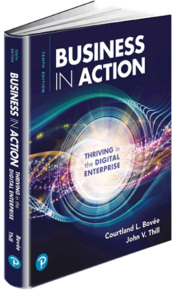 How Business in Action Helps Instructors Overcome the Top 10 Challenges
How Business in Action Helps Instructors Overcome the Top 10 Challenges
Business in Action is a comprehensive and engaging Introduction to Business textbook that provides instructors with the tools and resources to effectively address the challenges they face in the classroom. This article will explore how Business in Action helps instructors overcome the top 10 challenges mentioned in the previous article.
Diverse student backgrounds: Business in Action offers a clear and accessible writing style that caters to students from various backgrounds. The textbook provides a solid foundation of business concepts, making it easier for instructors to bridge knowledge gaps and ensure all students are on the same page.
Keeping content up-to-date: Business in Action is regularly updated to include the latest business trends, case studies, and real-world examples. The textbook's online resources, such as the MyLab Intro to Business platform, provide instructors with access to current articles, videos, and other supplementary materials.
Balancing theory and practice: Business in Action strikes an optimal balance between theoretical concepts and practical applications. Each chapter includes real-world examples, case studies, and practical exercises that help students understand how business theories apply in practice.
Engaging students in online courses: The MyLab Intro to Business platform, which complements Business in Action, offers a range of interactive features, such as simulations, videos, and adaptive learning tools. These resources help instructors keep students engaged and motivated, even in online course settings.
Addressing different learning styles: Business in Action caters to different learning styles by incorporating a variety of pedagogical elements, such as visual aids, infographics, and hands-on activities. The textbook's online resources also provide instructors with additional multimedia content to support various learning preferences.
Integrating technology: Business in Action seamlessly integrates technology through the MyLab Intro to Business platform. This platform offers a user-friendly interface, making it easy for instructors to incorporate digital tools and resources into their courses.
Developing critical thinking skills: Business in Action emphasizes the importance of critical thinking throughout the textbook. Each chapter includes thought-provoking questions, case studies, and problem-solving exercises that encourage students to analyze business issues from multiple perspectives.
Addressing ethical concerns: Business in Action dedicates an entire chapter to business ethics and corporate social responsibility. The textbook presents ethical dilemmas and real-world examples to help instructors facilitate meaningful discussions and promote ethical decision-making in business.
Providing individualized attention: The MyLab Intro to Business platform offers personalized learning paths and adaptive study plans that help instructors provide individualized attention to each student. The platform's gradebook and reporting features also make it easier for instructors to monitor student progress and provide targeted support.
Assessing student learning: Business in Action provides a range of assessment tools, including end-of-chapter quizzes, test banks, and project ideas. The MyLab Intro to Business platform also offers automated grading and immediate feedback, saving instructors time and helping students track their progress.
Business in Action is an ideal textbook for Introduction to Business courses, as it effectively addresses the top 10 challenges faced by instructors. By providing up-to-date content, engaging pedagogical elements, and seamless technology integration, Business in Action empowers instructors to create a dynamic and effective learning experience for their students.
Shining a Light on Greenwashing: Consumers Take Aim at Deception in the Sustainability Market
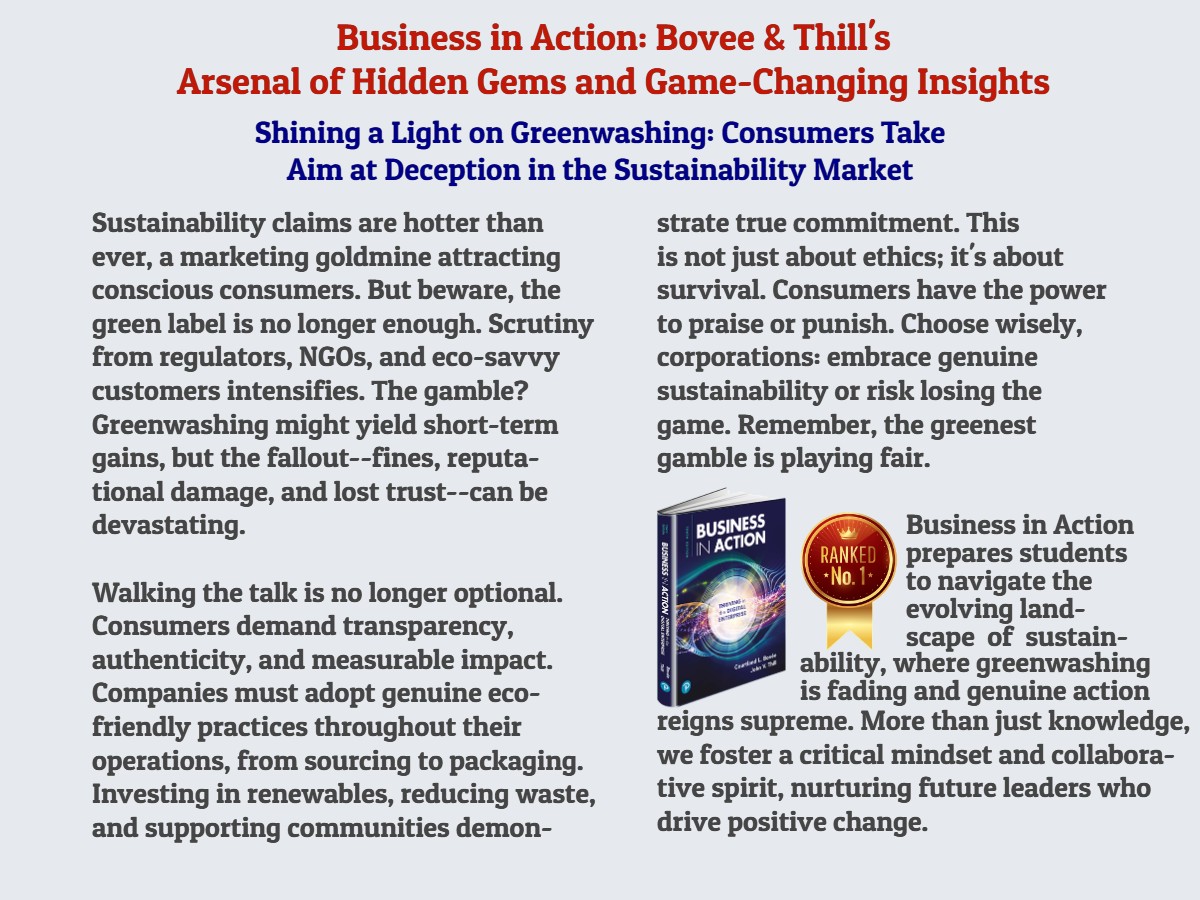
Discussion Question 1: How can companies effectively communicate their sustainability efforts to consumers without being accused of greenwashing?
Answer: Companies must prioritize transparency and authenticity when communicating their sustainability efforts to consumers. They should provide detailed information about their eco-friendly practices, including specific goals, progress, and challenges faced. This can be achieved through comprehensive sustainability reports, third-party certifications, and clear labeling on products.
To avoid accusations of greenwashing, companies should focus on measurable impact rather than vague claims. They can share data on carbon emissions reduced, renewable energy used, waste minimized, and resources conserved. Collaborating with respected environmental organizations and participating in industry-wide sustainability initiatives can further validate their commitment.
Moreover, companies should engage in open dialogue with consumers, addressing their concerns and seeking feedback. They can utilize social media, customer service channels, and educational campaigns to foster trust and credibility. By being proactive, consistent, and genuine in their sustainability communication, companies can build long-lasting relationships with eco-conscious consumers.
Discussion Question 2: What are the long-term benefits for companies that invest in genuine sustainability practices, and how can they outweigh the short-term costs?
Answer: Investing in genuine sustainability practices offers companies significant long-term benefits that can outweigh the short-term costs. Firstly, adopting eco-friendly practices can lead to operational efficiency and cost savings. By reducing energy consumption, minimizing waste, and optimizing resource use, companies can lower their expenses and improve their bottom line over time.
Secondly, genuine sustainability enhances brand reputation and customer loyalty. As consumers become increasingly aware of environmental issues, they are more likely to support companies that demonstrate authentic commitment to sustainability. By consistently delivering on their eco-friendly promises, companies can differentiate themselves from competitors, attract conscious consumers, and foster long-term brand advocacy.
Moreover, investing in sustainability positions companies for future regulatory compliance and market demands. As governments introduce stricter environmental regulations and investors prioritize ESG (Environmental, Social, and Governance) factors, companies with established sustainability practices will be better prepared to adapt and thrive in a changing business landscape.
Additionally, genuine sustainability can drive innovation and create new business opportunities. By focusing on eco-friendly products, services, and technologies, companies can tap into growing markets and meet evolving consumer preferences. This can lead to increased market share, revenue growth, and long-term competitiveness.
While the initial costs of implementing sustainability practices may seem daunting, the long-term benefits—including cost savings, enhanced reputation, customer loyalty, regulatory resilience, and innovation—can far outweigh the short-term investments. Companies that prioritize genuine sustainability are not only contributing to a greener future but also positioning themselves for long-term success in an increasingly environmentally conscious world.
 Business in Action is a comprehensive textbook that equips students with the knowledge and skills needed to navigate the dynamic world of business. By covering a wide range of topics, from fundamental concepts to contemporary issues, the book prepares students to make informed decisions and tackle real-world challenges.
Business in Action is a comprehensive textbook that equips students with the knowledge and skills needed to navigate the dynamic world of business. By covering a wide range of topics, from fundamental concepts to contemporary issues, the book prepares students to make informed decisions and tackle real-world challenges.
One of the key aspects addressed in the textbook is the importance of ethical and sustainable business practices. Through case studies and examples, such as the greenwashing scenario mentioned above, students learn to critically analyze corporate behavior and its impact on consumers, society, and the environment. The book emphasizes the significance of transparency, authenticity, and measurable impact in sustainability claims, helping students develop a keen eye for identifying and avoiding greenwashing tactics. By exploring the long-term benefits of genuine sustainability practices, "Business in Action" encourages students to prioritize ethical decision-making and contribute to building a more responsible and sustainable business landscape.
Moral Hazard and Ethical Dilemmas
The Truth about Loyalty Programs: Customer Magnet or Pointless Pursuit?
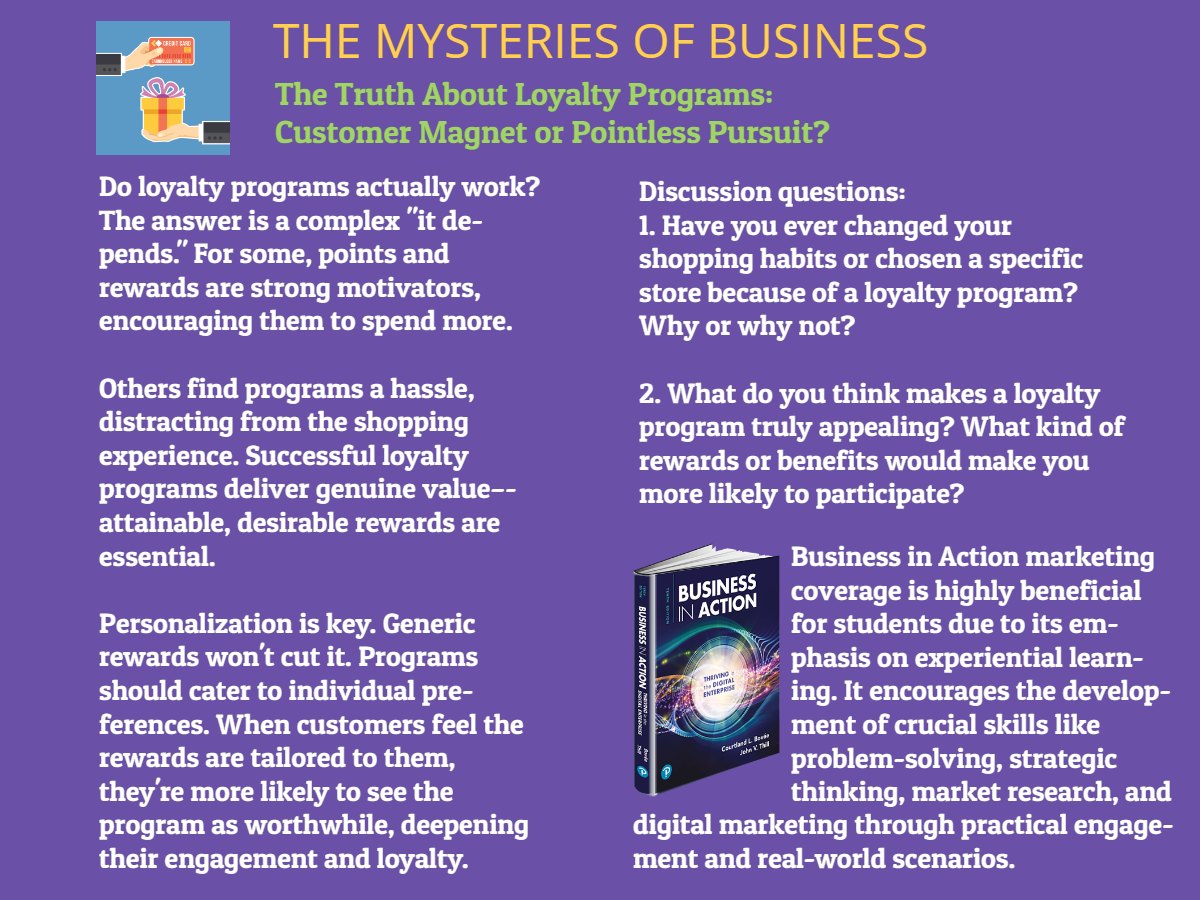
Here are answers to the discussion questions:
- Have you ever changed your shopping habits or chosen a specific store because of a loyalty program? Why or why not?
Yes, I have changed my shopping habits and chosen specific stores because of their loyalty programs. For example, I frequently shop at a particular grocery store chain because of their rewards program, which offers points for every dollar spent that can be redeemed for discounts on gas or future purchases. I find this program valuable because the rewards are easy to earn and redeem, and they provide tangible savings on products I would buy anyway.
However, I have also avoided certain loyalty programs that felt too complicated or didn't offer rewards that were meaningful to me. I once signed up for a clothing store's loyalty program but never used it because the points system was confusing and the rewards didn't align with my shopping preferences.
- What do you think makes a loyalty program truly appealing? What kind of rewards or benefits would make you more likely to participate?
For me, a truly appealing loyalty program is one that offers:
- Simplicity: The program should be easy to understand and use, with clear rules for earning and redeeming rewards. Complicated points systems or excessive restrictions can be frustrating and discourage participation.
- Relevant rewards: The rewards offered should be things that I actually want or need. Discounts on products I regularly buy, exclusive access to sales or products, or even personalized recommendations based on my shopping history would all be appealing incentives.
- Attainable rewards: The rewards should feel achievable within a reasonable timeframe. If it takes an extremely long time or an unrealistic spending amount to earn a meaningful reward, I'm less likely to engage with the program.
- Flexibility: I appreciate loyalty programs that offer multiple ways to earn and redeem rewards, such as earning points through purchases, referrals, or engaging with the brand on social media, and the ability to choose from various reward options.
- Integration with my shopping experience: A loyalty program that seamlessly integrates with my typical shopping experience, such as a mobile app that tracks my points and offers personalized deals, would make me more likely to participate consistently.
Ultimately, a loyalty program that demonstrates a genuine understanding of my preferences and offers value that enhances my shopping experience would be most appealing and effective in securing my ongoing business.
 Business in Action is the ideal choice for any Introduction to Business instructor seeking to provide their students with a comprehensive, engaging, and practical learning experience. This textbook stands out for its clear and accessible writing style, which effectively explains complex business concepts in a way that resonates with students from diverse backgrounds. The content is carefully organized and updated to reflect the latest trends and challenges in the dynamic world of business, ensuring that students gain relevant and applicable knowledge.
Business in Action is the ideal choice for any Introduction to Business instructor seeking to provide their students with a comprehensive, engaging, and practical learning experience. This textbook stands out for its clear and accessible writing style, which effectively explains complex business concepts in a way that resonates with students from diverse backgrounds. The content is carefully organized and updated to reflect the latest trends and challenges in the dynamic world of business, ensuring that students gain relevant and applicable knowledge.
With its rich array of real-world examples, case studies, and practical applications, Business in Action helps students bridge the gap between theory and practice, fostering critical thinking, problem-solving, and decision-making skills that are essential for success in today's competitive business landscape. Moreover, the textbook's robust suite of supplementary materials, including online resources, such as the powerful MyLab (now supported by artificial intelligence), and interactive learning tools, enhances student engagement and supports various teaching styles. By choosing Business in Action, instructors can be confident that they are providing their students with a solid foundation for understanding the multifaceted nature of business and preparing them for the challenges and opportunities that await them in their future careers.
Intellectual Property: Friend or Foe?
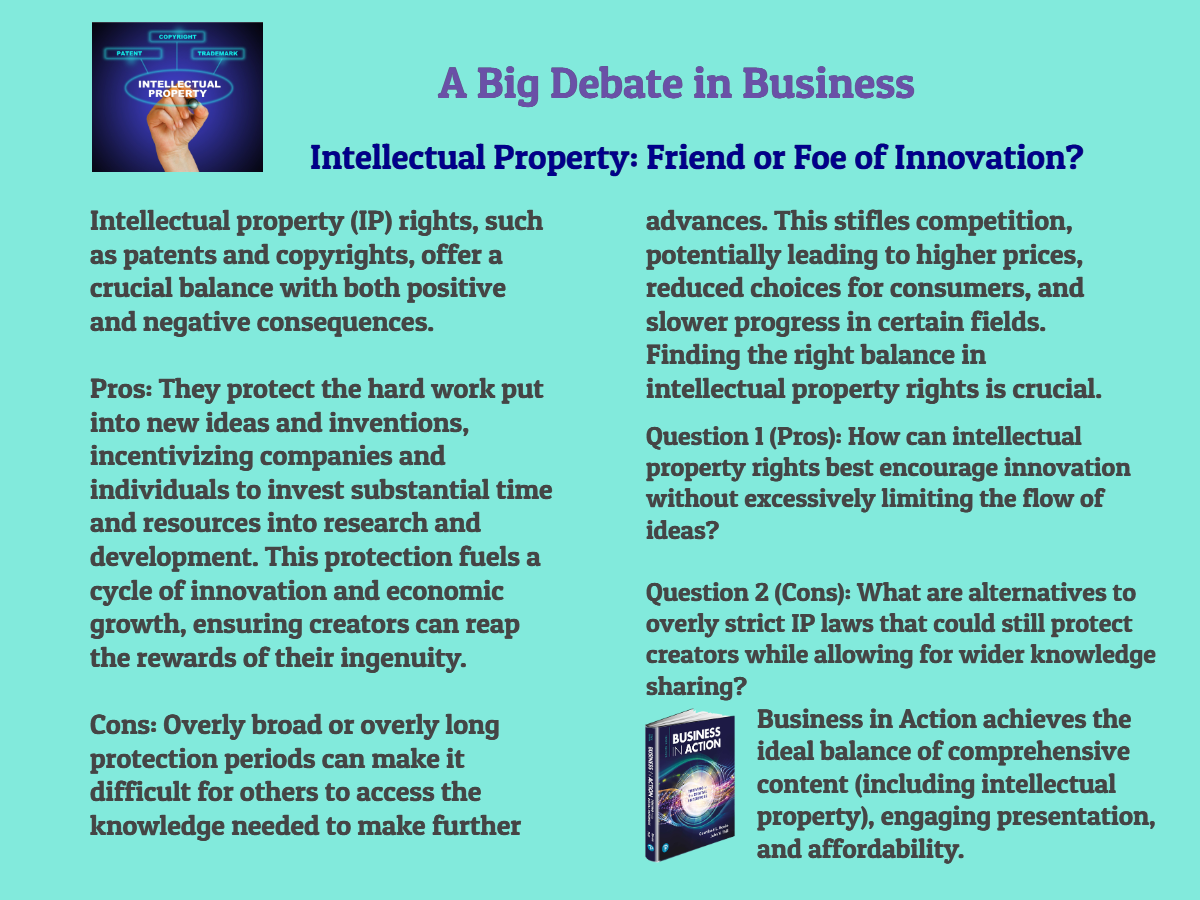
Answers to Discussion Questions:
Question 1: Have you ever changed your shopping habits or chosen a specific store because of a loyalty program? Why or why not?
Answer 1 (Yes): "Yes, I definitely choose stores sometimes based on their rewards. If I'm comparing similar items, I might go for the one at a place where I earn points towards something I actually want."
Answer 2 (No): "Not really. I find loyalty programs usually too complicated. I'm less likely to shop somewhere if I have to keep track of a card or app for minimal rewards."
Question 2: What do you think makes a loyalty program truly appealing? What kind of rewards or benefits would make you more likely to participate?
Answer 1 (Value): "I like immediate benefits, like small discounts or free samples with a certain amount spent, rather than needing to save points for ages."
Answer 2 (Personalization): "Rewards based on my purchase history would be great. If I frequently buy items from a certain category, offers or coupons related to that would be much more enticing."
 Business in Action covers intellectual property rights and their implications in a balanced manner that informs students about both the pros and cons. Here are some ways it may address this topic:
Business in Action covers intellectual property rights and their implications in a balanced manner that informs students about both the pros and cons. Here are some ways it may address this topic:
-
Defining Intellectual Property Rights The book likely provides clear definitions and explanations of different forms of IP protection like patents, copyrights, trademarks, etc. and their purpose in protecting innovators' work.
-
Rationale for IP Rights It explores the rationale behind IP rights – incentivizing innovation by allowing creators/inventors to reap rewards from their efforts, thereby fueling economic growth. This ties to the "pros" you mentioned.
-
Types of IP Violations
The textbook probably discusses different violations like patent infringement, piracy, counterfeiting etc. to explain what constitutes IP theft or misuse.
-
Costs and Consequences It likely examines the potential downsides of overly broad/lengthy protections that can stifle competition, raise costs for consumers and inhibit subsequent innovation – aligning with the "cons" noted.
- Case Studies Using real-world examples and legal cases, the book illustrates the nuances of IP rights and the delicate balance required between incentivizing innovation and enabling access/progress.
The Great Democratization of Innovation: Unleashing the Power of Citizen Science in Business
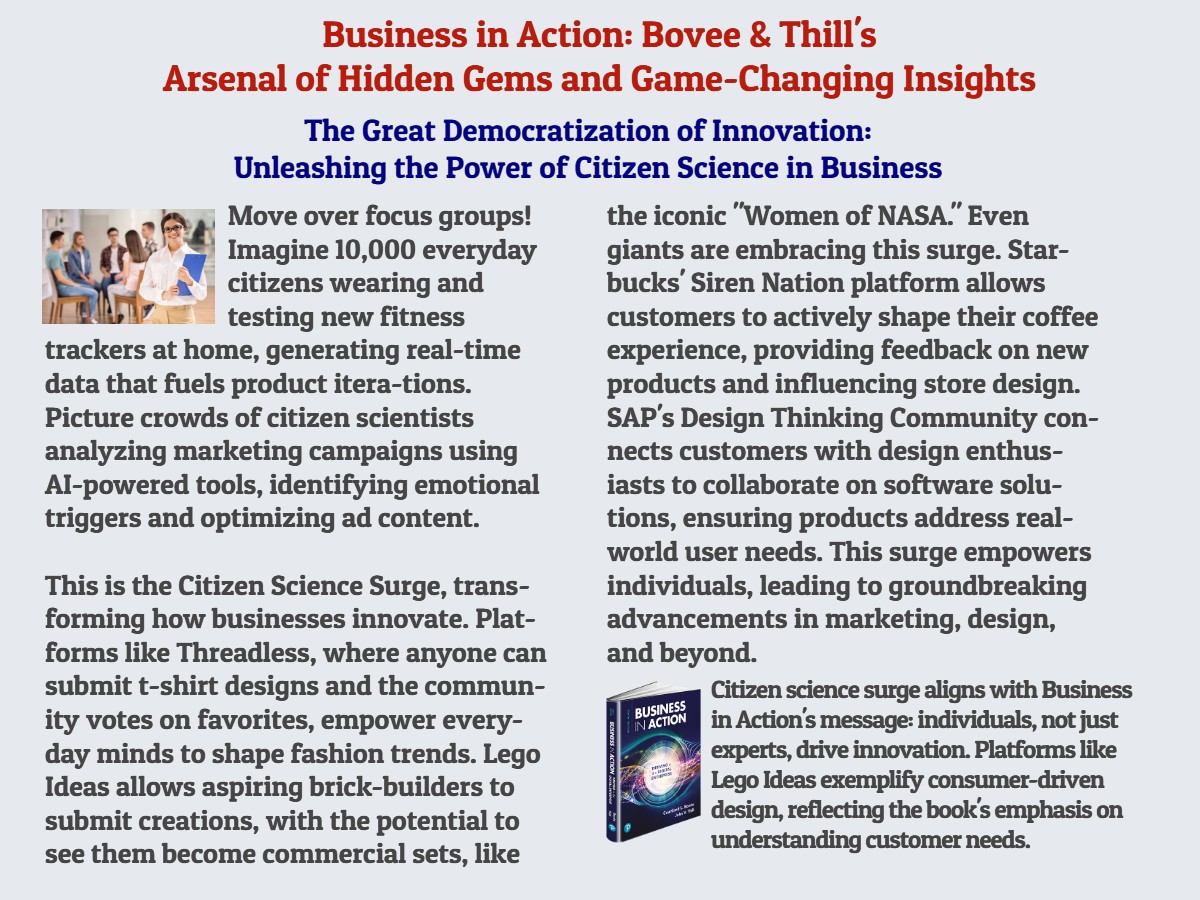 Discussion Questions and Answers:
Discussion Questions and Answers:
1. Question: This article describes the "Citizen Science Surge" as a positive development. Are there any potential downsides or ethical considerations businesses should be aware of when relying on citizen scientists?
Answer: While the Citizen Science Surge holds immense potential, some potential downsides and ethical considerations exist.
These include:
Data privacy and security: Gathering data from thousands of individuals raises concerns about data privacy and security. Businesses must ensure robust data protection measures and transparent communication with participants.
Bias and representativeness: A large, but non-representative sample of "citizen scientists" might lead to biased results that don't reflect the broader population. Businesses should consider ensuring participant diversity and representativeness.
Exploitation and fair compensation: Citizen scientists contribute valuable data and insights. Businesses should consider fair compensation models or offer meaningful rewards for participation.
Ethical AI usage: Using AI for analysis raises ethical questions about accountability, transparency, and potential discrimination based on AI biases. Businesses need responsible AI development and deployment practices.
2. Question: The article focuses on businesses embracing the Citizen Science Surge. How can individuals leverage this trend to participate and contribute?
Answer: The Citizen Science Surge offers exciting opportunities for individuals to:
Contribute to meaningful projects: Individuals can join platforms like Threadless, Lego Ideas, or citizen science projects on SciStarter to directly shape products, campaigns, or research.
Develop new skills: Platforms often provide training and resources, allowing individuals to learn new skills in design, data analysis, or scientific research.
Connect with communities: Citizen science fosters collaborative communities where individuals can connect with like-minded people, share ideas, and contribute to collective advancements.
Gain recognition and rewards: Some platforms offer recognition and rewards for outstanding contributions, motivating individuals to engage actively.
Bonus Discussion:
What other industries could benefit from the Citizen Science Surge?
How can technology be used to further empower citizen scientists and ensure the success of this trend?
Key Business in Action Concepts and Their Connection to the Surge
- Market Research: Citizen science projects are essentially large-scale, organic market research. Real-time product data from thousands of 'citizen testers' yields invaluable insights faster than traditional focus groups. Companies directly assess customer reactions and preferences, driving product design choices.
- Consumer-Driven Innovation: The surge transforms innovation from an internal process to a collaborative one. It aligns with the idea that businesses must be receptive to customer needs, even using consumer-created designs (Threadless, Lego Ideas). This blurs the line between producer and consumer.
- Co-creation & Crowdsourcing: Platforms that invite consumer participation embody the value of co-creation and crowdsourcing. Companies recognize that expertise and innovative ideas can reside outside their traditional R&D departments.
- Data Analytics: The surge generates immense datasets. Companies need analytics capabilities, often powered by AI tools to make sense of this influx of data. Business in Action often introduces the strategic importance of data analysis.
- Agile Development: Real-time customer feedback allows companies to adopt a more agile development approach. Rapid product iterations based on user data are emphasized in modern business strategies, contrasting with lengthy traditional product development cycles.
Beyond the Textbook: Additional Perspectives
- Democratization of Innovation: This surge makes innovation accessible to a broader range of people. In the past, design and product choices often resided solely within the company. Now, anyone with a good idea can potentially influence a product or marketing strategy.
- Collective Intelligence: Citizen science leverages the power of collective intelligence–the idea that groups can be collectively smarter than individuals. Diverse perspectives and insights are harnessed by businesses.
- Ethics and Transparency: This model raises questions businesses need to grapple with. How do they ensure fair compensation (if any) for citizen contributions? How do they maintain transparency regarding the use of data and ideas?
See the Business in Action brochure: https://lnkd.in/ebQFKB4t. Video: https://lnkd.in/epDtr6jd. How Does Your Current Text Compare: https://lnkd.in/eSzpc5P8. To request an examination copy of Bovee and Thill's award-winning Introduction to Business text, Business in Action (instructors only), visit https://lnkd.in/eDfhNKJ.
The Hyperlocal Uprising Reshaping Retail

Discussion Questions about the Hyperlocal Hustle Reshaping Retail:
1. How can local businesses leverage the "hyperlocal hustle" to compete with larger chains and online retailers?
Answer:
The hyperlocal hustle presents unique opportunities for local businesses to thrive:
Community focus: Build strong relationships with local customers by understanding their needs and preferences. Offer products and services specifically tailored to the community. Host events and initiatives that foster a sense of belonging.
Direct-to-consumer: Utilize online platforms and social media to connect directly with customers, bypassing middlemen and reducing costs. Offer delivery, pickup, and subscription options for convenience.
Experiential retail: Create a unique and engaging shopping experience that larger chains lack. Offer personalized service, workshops, tastings, or other interactive elements. Highlight the human connection and local stories behind your products.
Partnerships: Collaborate with other local businesses for cross-promotion, joint events, or shared resources. This strengthens the local ecosystem and attracts more customers.
Agility and innovation: Be adaptable to changing trends and customer preferences. Experiment with new ideas and embrace technology to improve efficiency and reach.
2. What are the potential challenges and drawbacks of the hyperlocal hustle for consumers and businesses alike?
Answer:
While the hyperlocal movement holds promise, there are potential challenges to consider:
Limited selection: Smaller stores may not have the same variety of products as larger chains.
Price competition: Local businesses may struggle to compete on price with national brands with economies of scale.
Marketing reach: Reaching a wider audience can be difficult without significant marketing resources.
Technological adoption: Implementing online platforms, delivery systems, and other tech solutions can require investment and expertise.
Consumer trust: Building trust and brand recognition takes time and effort, especially for new businesses.
For consumers, the drawbacks might include:
Higher prices: Supporting local businesses often comes at a premium compared to mass-produced goods.
Limited availability: Certain products or services may not be available locally.
Convenience: Shopping at multiple local stores can be less convenient than a one-stop shop at a larger chain.
Overall, the hyperlocal hustle presents an exciting opportunity for both businesses and consumers, but careful consideration of the challenges is crucial for long-term success.
Teach the Four Ways Artificial Intelligence Is Changing Business
 "Artificial intelligence's impact on the world is momentous, yet it can feel almost invisible at the same time. Consider modern conveniences like Netflix recommendations, Facebook's suggested articles, and even Google's search page. These are all the result of AI, and they've become so ingrained in peoples' daily lives that they are almost unnoticed."
"Artificial intelligence's impact on the world is momentous, yet it can feel almost invisible at the same time. Consider modern conveniences like Netflix recommendations, Facebook's suggested articles, and even Google's search page. These are all the result of AI, and they've become so ingrained in peoples' daily lives that they are almost unnoticed."
Note; Business in Action, 10th Edition, has extensive coverage of artificial intelligence. To request an examination copy, click "Order an Examination Copy" immediately above in the red navigation bar.
23 Staggering Small Business Facts

Ever since the pandemic first broke out, small businesses and their welfare have become some of the most talked-about subjects.
After all, many had no choice but to shut down; and while some did so only temporarily, others closed permanently. Yet, new ones have already begun to pop up—at a rate higher than ever before.
To better understand their importance in the -pandemic world, we have compiled a not-so-small list of small business facts, some of which are sure to astound you.
Read more . . .